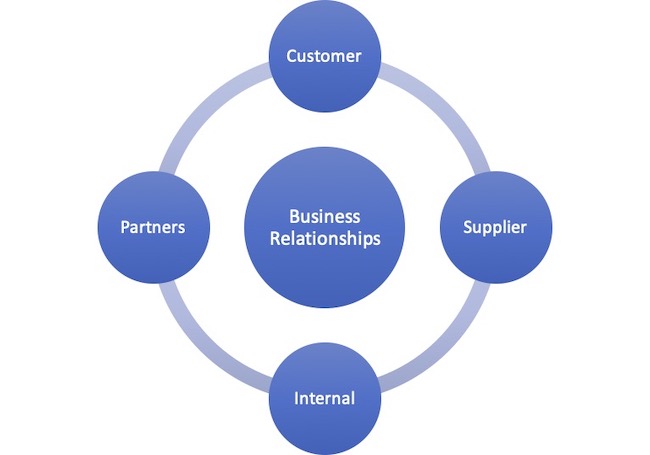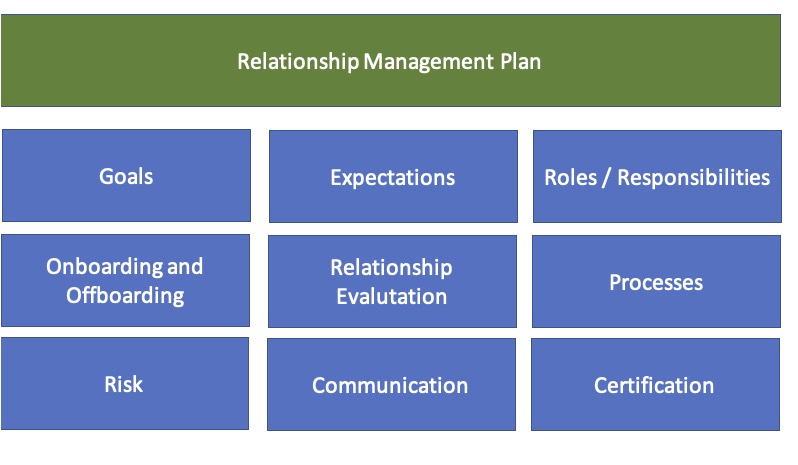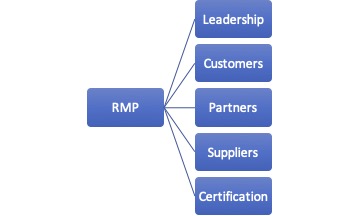A relationship management plan provides a roadmap for how an organization approaches relationships and collaboration with its stakeholders (whether they are customers, suppliers, partners, or internal functions).

It is often associated with ISO44001, as being a constituent part of the standard, and differs from a Customer relationship management plan (CRSM) by encompassing all organizational relationships and collaboration.
In today’s article, we’ll be looking at the role of the Relationship Management Plan and how you can use it to add value to your organization.
- What is a relationship management plan
- Relationship Management plan and ISO44001
- What are the key characteristics of a relationship management plan
- What are the Goals and Objectives of a Relationship Management Plan
- Why is there a need to build strong relationships?
- Who are the key stakeholders of a Relationship Management Plan
- What are the key impacts on relationships
- How to Write a Relationship Management Plan
- How to evaluate the success of a relationship management plan
- Benefits of a relationship management plan
- Issues with a relationship management plan
What is a relationship management plan?
Increasingly businesses rely on transparent, collaborative and mutually beneficial relationships in order to deliver value to their customers and deliver organizational effectiveness.
Collaboration, in order to be successful, needs both engagement between stakeholders and a level of alignment between processes.
Organizations are likely to have a range of relationships that are important to their success. These are likely to include:

- Customer relationships
- Supplier Relationships
- Partner Relationships
- Functional relationships (internal)
Many organizations manage, with varying degrees of success, these relationships outside of an enterprise encompassing, formal process.
Structure and method, however, provide a greater chance of success.
A relationship management plan aims to provide both, looking to provide a plan around how collaborative relationships will be identified, developed and managed.
Relationship management plans help define and formally capture:
- Goals
- Expectations
- Roles and accountability pertaining to relationship development
- Entry and exit points of relationships
- Associated processes that deliver effective relationships.

Relationship management plans can be drawn up to support an organization, an activity, or a single (or specified group of) relationship(s).
The key aspect of the relationship management plan is that it provides an organization with a structural approach to follow, which provides a greater chance of success than without.
A relationship management plan helps an organization consider what makes a collaborative relationship successful and then provide a process to achieve it, whether that’s defining goals and success factors through to the processes it will use.
Additional benefits are that a thorough, methodical approach to relationships can also provide ways of
- Reducing Risk
- Increasing Efficiency
- Improving communication
- Provide ways of evaluating progress
- Provide opportunities for certification (ISO 44001).
Using a relationship management plan (and achieving certification to the 44001 standard) is not limited to a particular industry, and any organization looking to improve its collaboration process can find value in its use.
Relationship Management plan and ISO44001
ISO 44001 is the international standard associated with business relationships; it has several characteristics associated with relationships, including
- Establishing relationships,
- Managing relationships
- Evaluating relationships
- Improving relationships.
It aims to provide a roadmap for collaborative relationships.
These relationships can be in all directions, including:
- Customers
- Suppliers
- Partners
- Internal
Using a structured approach, a business can use ISO44001 to build a culture of collaboration and manage relationships through their lifecycle (from creating, maintaining and exiting).
ISO 44001 provides guidance on how organizations may achieve this through utilizing a Relationship Management Plan as the framework for how relationships are delivered.
What are the key characteristics of a relationship management plan?
Characteristics of a relationship Management Plan include:
- Scope
- Goals
- Methods and Processes
- Evaluation and performance management
- Continuous improvement
- Roles, responsibilities
- Managing risk and opportunity
What are the Goals and Objectives of a Relationship Management Plan
The goals of different organizations can, of course, vary. However, these are likely to include:
- Building or enhancing meaningful relationships
- Helping to deliver a goal or goals
- Improving communication
- Helping to highlight and reduce risk
- Providing a framework to help reduce conflict
- Build trust and transparency.
- Provide a mechanism for evaluating relationships.
- Have clear lines of responsibilities
- Describe how collaboration (and relationships) start and stop.
Why is there a need to build strong relationships?
Businesses are not an island, and we need to interact with stakeholders in order to deliver business goals.
Therefore our business’s effectiveness is inextricably linked with the effectiveness of relationships.
Improve the business’s relationships, and the effectiveness of the business increases.
Some examples,
- If we build strong relationships with our customers, we are more likely to understand their needs and deliver products and services that meet them.
- If we build strong relationships with our suppliers, we can help mitigate risk and drive innovation.
Who are the key stakeholders of a Relationship Management Plan
The key stakeholders of a Relationship Management Plan can include:

- Organization Leadership helping to drive overall strategy.
- Employees and functional areas:
- Customers: The success of any business rests on the type of relationship that the business has with its customers
- Partners: Organizations that collaborate with the business to deliver shared objectives
- Suppliers:
- Certification bodies
How do businesses impact relationships?
Organizations impact relationships in a number of ways, these include:
- Effectiveness of communication
- Trust (or lack of it) between organizations
- Negotiation
- How conflicts or disputes are resolved
- Establishing areas of mutual benefits
- Understanding dependencies
- Understanding differences
- Understanding dynamics within the relationship (such as power and control)
Understanding these aspects can help in the formation of the management plan as we are better placed to understand the processes and measures that need to be in place to drive effectiveness.
How to Write a Relationship Management Plan
The relationship management plan is likely to be unique pertaining to the organization and/or the project it relates to; however, some common features include:
- Scope – Detailing the scope of the RMP and what aspects of the business it relates to (for example, shared processes and how the information will be communicated). As we stated earlier, this could vary and include the whole organization, a single project or a single relationship.
- Objectives: Stated goals and objectives of the relationship management plan
- Visions, Values and Behaviours
- Constraints
- Engagement rules – what processes will be engaged and how
- Stakeholder analysis: Analysis of the key stakeholders involved in the relationship.
- Primary Roles and Responsibilities: Defining the roles and responsibilities of each party in the relationship and their role in implementing the relationship management plan – this will typically involve organizational analysis.
- Communication plan: Detailed steps articulating how communication will be managed between stakeholders
- Conflict resolution plan: The process for how conflicts or issues will be resolved.
- Risk & Opportunities
- Performance measurement: How will the plan and resultant value be evaluated (perhaps through the use of metrics)
- Continuous improvement: Detailed steps regarding how continuous improvement will be implemented with all stakeholders
- Review: How the plan will be reviewed and revised to ensure relevancy and effectiveness.
- Exit or disengagement processes
How to evaluate the success of a relationship management plan
One of the key questions is whether a business that has invested in building and developing a relationship management plan is better off than those organizations that haven’t.
All relationships are different, and the Relationship Management Plan should clearly articulate how its success would be measured; this could including a range of hard and soft measures such as:
- Perceived Trust
- Relationship retention or attrition
- Number of Shared goals
- Ability to manage disagreements
- Effectiveness of onboarding/offboarding
And of course, there are more traditional measures, such as:
- Impact to customer
- Quality
- Cost
- Delivery
Benefits of a relationship management plan
Relationship management plans aim to drive organizational effectiveness through collaboration; there are various associated benefits, including:
- Clear goals pertaining to collaboration, leading to greater focus
- Increased levels of collaboration around achieving shared goals
- Transparency
- More effective communication driving organizational engagement
- Clear roles and responsibilities accross orgnaizaitons
- Increased levels of organizational effectiveness as partners levy the benefits of collaboration
- Structure process for engagement minimizing uncertainty
Issues with a relationship management plan
Relationships are a challenging aspect of business to get right and can be dependent on many factors. A variety of issues can emerge, which include:
- The plan is documented and not followed
- Leadership-driven, the organization doesn’t buy-in
- Unclear of what value is required to be delivered
- Ineffective when it comes to resolving disputes
- Fails to account for cultural differences of organizations or participants
- Assumes alignment on goals
- Existing relationships may bring with them problems that the plan fails to account for.
Summary
A relationship management plan ( whether in support of ISO 44001 or not) provides a mechanism for driving effectiveness between organizations pushing for shared goals.
While different projects and organizations might drive specific requirements, a relationship management plan should, in its most basic form, include objectives, scope and processes pertaining to managing relationships (entry, engagement, exit).
Leveraging relationship management plans can provide businesses with higher levels of effectiveness and reduced risk. Through their regular evaluation, businesses can make informed decisions that drive value.
Has your organization used relationship management plans? Perhaps you’re looking to certify in ISO44001; as ever, we’d love to hear about your experience; you can reach us in the feedback section below or via Twitter.
